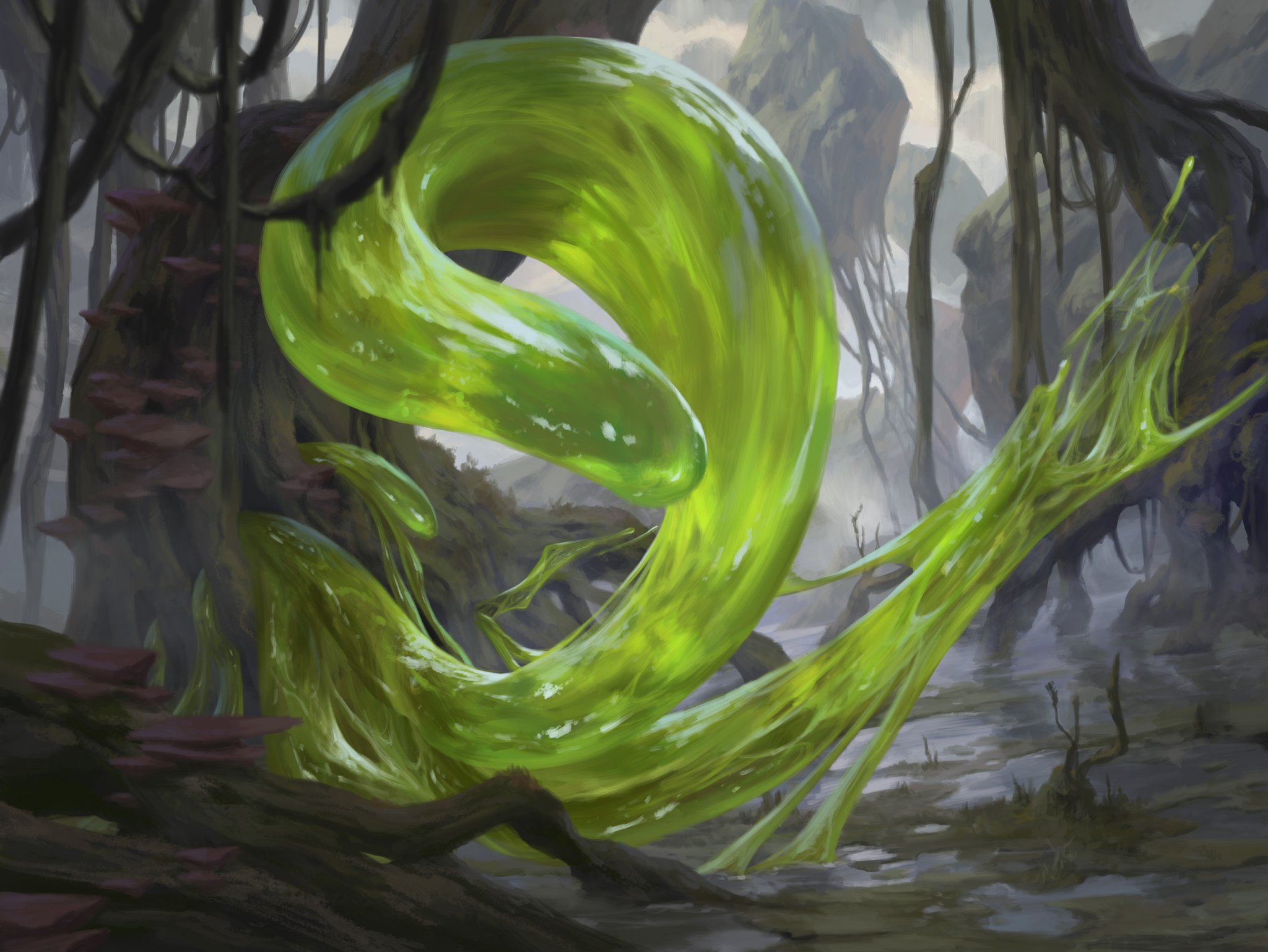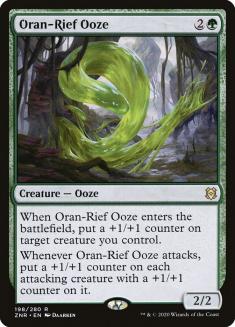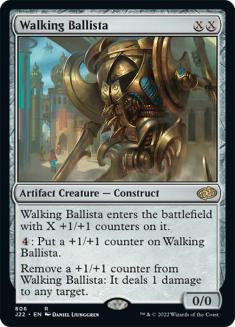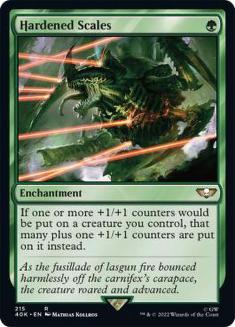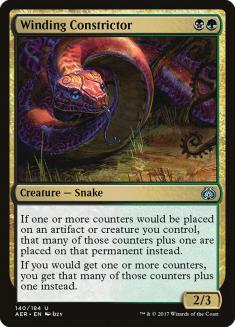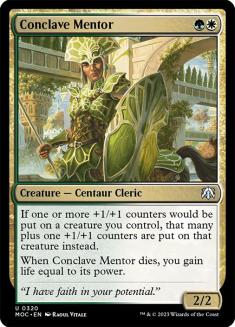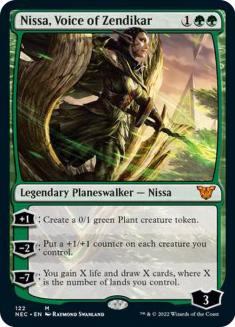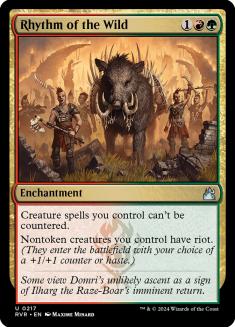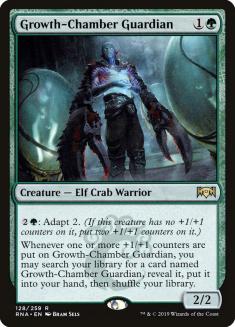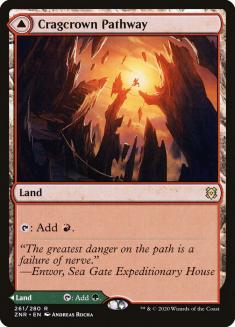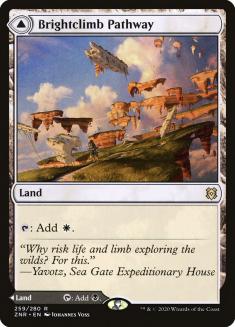A few days ago, I did a mini-set review with Ryan Overturf on my Twitch channel where we went over just about ever card we considered Constructed-playable. A lot of the flashier ones have already been discussed on this here website, with great minds building and brewing with all these new tools. With the big fall rotation come a lot of potential, a small card pool, and a lot of new decks.
I tend to lean toward the weird and wonderful, looking for cool new cards that could add a dimension to existing archetypes, but I often find myself gravitating toward the familiar. Zendikar Rising has a lot of “callback” cards, with twists on old favorites. There’s a lot to love because there is obviously a lot of love on this plane. You can tell from the flavor texts to the artwork that there was so much heart shoved into every piece, and so much thought on how these cards impact the universe they’ve created.
A few months ago, I wrote an article about a “new” archetype for Pioneer that utilized three different cards that doubled the counters you placed on creatures, lovingly dubbed “12 Scales.” This deck used Hardened Scales, Winding Constrictor, and Conclave Mentor alongside a ton of creatures and permanents that generated +1/+1 counters. It’s been a staple of Pioneer over the last year, and has only gotten more weapons for the arsenal. One creature from Zendikar Rising grabbed my attention in particular.
The enters-the-battlefield ability is similar to Rishkar, Peema Renegade, albeit a little bit worse. You also don’t have the spots to gain bursts of mana from Rishkar’s static effect. However, Oran-Rief Ooze has one thing going for it that Rishkar, Peema Renegade does not: if you untap with it, I reckon you’re going to win the game.
Attacking with Oran-Rief Ooze and any other creature will likely result in a tidal wave of counters. If you time things right, a single attack with Oran-Rief Ooze should give you such a burst of power that blocking becomes impossible. This is only furthered by the twelve cards in the deck that double those counters, instantly turning your entire squad into monsters. A single token creature or Llanowar Elves transforms into something much greater than itself. This effect is exacerbated by cards in your deck that add counters to multiple creatures at once. Ensuring all your creatures have at least one counter on them should be easy.
When talking about Pioneer specifically, the deck is mostly intact and Oran-Rief Ooze can fit right in. Being a green-only threat also means it’s much easier to cast, offering some stellar draws that start with Elvish Mystic or Llanowar Elves. When you’re on the play and put this on the battlefield early, untapping with it might be easier than you think. If you add the counter to itself immediately, it might be safe from Wild Slash and Stomp. Without some help, it also dodges Fatal Push. Three-drops with three or more toughness are a soft spot in the played removal. It’s one of the reasons why Hanweir Garrison was actually reasonable over Legion Warboss in some builds of Chonky Red.
Here’s where I want to start.
Creatures (24)
- 4 Experiment One
- 4 Winding Constrictor
- 4 Pelt Collector
- 4 Stonecoil Serpent
- 4 Conclave Mentor
- 4 Oran-Rief Ooze
Planeswalkers (7)
Lands (22)
Spells (7)

This version has an aggressive slant to it. All your threats tend to work with one another to create a large amount of power and toughness for a small mana investment. Dedicated interaction and disruption can make this plan fall apart. Something like Sultai Midrange featuring some sweeper effects like Extinction Event and a ton of spot removal like Fatal Push can be a nightmare. However, there are a lot of draws from this deck that few decks can beat.
The goldfish speed and consistency of this archetype is outrageous. Expecting your opponent not to interact with you is a pipe dream, but I’ve just had such great experiences playing this style of deck against opponents who are trying to do their own thing. You might do yourself a little damage from your lands, but chances are that your draw will feature one of your twelve engines and a slew of creatures and planeswalkers that interact favorably with it.
The loss of Walking Ballista cannot be overstated. It was an integral part of the archetype that gave you reach, but it also helped neutralize a host of opposing threats. This version not having any sort of creature interaction in the maindeck means we might fall behind against an opposing Llanowar Elves deck. That isn’t always the case, but Mono-Green Superfriends is just about as consistent as us, but I don’t think they have the tools to protect themselves from our more busted draws. Outside of an errant Aligned Hedron Network, you should overwhelm them and their planeswalkers with ease.
Walking Ballista was “the reason” to play this deck, but that doesn’t mean it’s not good without it. Bans always hurt archetypes, but the enablers remain. If I’ve learned anything from playing Magic for so long, it’s that the true strength of any deck comes from the enablers more than the payoffs. If you generate 1000 mana, it doesn’t matter if Banefire gets banned as your kill condition. You can probably get the job done with any big X spell. You’re just losing to Cancel on occasion.
In this instance, there are few cards that can fill the shoes of Walking Ballista, a diverse threat that has seen play across every format where it has been legal. Colorless doesn’t always get “Fireball with legs,” and I doubt we’ll get anything close anytime soon. Like Hangarback Walker before it, Walking Ballista fit into a lot of different archetypes because it was just a great Magic card.
The soul of this deck radiates. Let’s take a look at the Hardened Triumvirate:
Hardened Scales and Winding Constrictor have been sticking together in older formats for a little while now. Hardened Scales specifically has shown that it has legs in formats as old as Modern. As Magic’s card pool grows, so does redundancy in effects. These three are the cheapest and most closely aligned cards of this type in all of Magic, to my recollection. There are a few others that do similar things, like Doubling Season, but none seem to work as well as these three.
Games that start with Hardened Scales aren’t exactly necessary in this list. In fact, I think you’d rather begin the game with Pelt Collector or Experiment One, getting the aggression going before your opponents are set up and ready. Having a slew of one-mana cards to play means your third turn is often absurd since you’re usually casting two spells. In actuality, each of your cheap cards is often worth more than the one-mana investment. Your one-mana creatures come to party as 3/3 or bigger on the regular, and without much effort.
The Hardened Triumvirate give this deck the staying power it needs, turbo-charging every card around them. Draws that feature one of these cards versus draws that feature none of these cards feel very different. If you don’t draw any of your enablers, chances are you’re probably going to lose. That’s why we play twelve iterations! Hardened Scales might actually be the worst of the bunch because it doesn’t naturally grow your Pelt Collector or Experiment One, but costing half the mana has its advantages when you’re trying to use all your mana each turn.
Of all the payoffs in the deck, Nissa, Voice of Zendikar is by far my favorite. In this list, I don’t know if you’ll hit the ultimate button too often, but every single minus should be devastating. Putting multiple counters on all your creatures just makes Nissa into a virtual Overrun that generates more bodies and be used an additional time in the face of a sweeper.
The planeswalker package is pretty cool in general, offering some variability in gameplay, but most of your more busted draws involve Nissa. If you’re trying to make Oran-Rief Ooze into a playable Magic card, having spells that put a +1/+1 counter on all your creatures is a must. It just so happens that Nissa is one of the most efficient ways to do that in all the relevant formats. It’s almost like they build new cards to pair well with old cards in certain formats.
Imagine, the foresight!
It might be worth looking at Oran-Rief Ooze in other ways. Giving it haste, for example, could be a nice way to get use out of its second ability. This is a card I’ve wanted to make playable for some time now.
Is Oran-Rief Ooze good enough to make Rhythm of the Wild playable? I hope so. A card I’ve long admired, Rhythm of the Wild gives me such flashbacks to Fires of Yavimaya. While that type of Magic might be outdated at this point, there’s a reason those cards were good in the first place. Pairing Fires of Yavimaya with powerful standalone threats like Saproling Outburst led to easy wins. These days, we might have to do things the fair way.
Rhythm of the Wild works nicely with a few different cards in Pioneer already, so let’s try to find the best build to support it completely.
Creatures (26)
- 4 Llanowar Elves
- 2 Voice of Resurgence
- 4 Elvish Mystic
- 4 Venerated Loxodon
- 4 Growth-Chamber Guardian
- 4 Conclave Mentor
- 4 Oran-Rief Ooze
Planeswalkers (4)
Lands (22)
Spells (8)
Sideboard

Rhythm of the Wild is such a unique card that splashing it could definitely be worth it. The ability to give your creatures haste or a +1/+1 counter fits pretty nicely into what is seemingly a Selesnya deck. The extra counters help make Hardened Scales a bit better, but the split nature of the enchantment leads to nice variability in gameplay. Finding lines that involve choosing haste versus the extra counter seems somewhat interesting, but I’m intrigued just to see how well it interacts with Oran-Rief Ooze.
Cards like Rhythm of the Wild tend to increase in value when both sides are often used and usually powerful. Giving an Oran-Rief Ooze haste in the right spot can look like an Overrun. Drawing a bunch of mana accelerants when you have Rhythm of the Wild means you can pump them up quite a bit. When combined with either Conclave Mentor or Hardened Scales, the added buff actually makes those mediocre late-game draws a bit more palatable. Decks that play Llanowar Elves are often more successful when they have a number of ways to make those bodies relevant in the late-game.
I have long tried to make this card playable. In decks that can freely add +1/+1 counters to their creatures, turning Growth-Chamber Guardian into a big Squadron Hawk is pretty cool. I find myself trying to do that more often than naturally paying the adapt cost, which probably means I’m trying a little too hard to make an okay card into something more than it isn’t.
Regardless, Rhythm of the Wild seems to pair nicely with Growth-Chamber Guardian here, but it isn’t the only one that does it. Your entire deck seems to be chock-full of ways to put more counters on creatures, which in turn finds you more Growth-Chamber Guardians, rinse and repeat. I hope that this is the deck that finally helps me crack that mold.
These two lands allow for easy splashing while still being green sources for first turn Llanowar Elves. Decks that play one-mana accelerators need their lands to tap for green and enter the battlefield untapped. That’s why you often see lands that deal you damage or have some significant cost or drawback being played over stuff like Rootbound Crag or Sunpetal Grove. While those lands see some play to compliment the rest of the two-color lands, there’s nothing more “feelsbadman” than a pair of Rootbound Crag ruining an otherwise perfect draw.
Cragcrown Pathway specifically helps multiple Gruul decks have better mana in Pioneer. We don’t have access to Copperline Gorge, but Cragcrown Pathway is almost as good, and might ultimately be better. I’m under the impression that these might be some of the best two-color lands ever printed, and allied color decks in Pioneer desperately needed the boost. Game Trail is just very very not good.
The fact that Naya currently gets two of these new lands to help cast Llanowar Elves into who-knows-what means I’ll be doing a lot of experimentation with this color combination in the coming weeks. Until the cycle is complete, I expect any color combination that can play two or more of these to be somewhat advantaged. Any color that leans heavily on one untapped specific color, and has two of these types of lands in that color, is the perfect fit.
Oran-Rief Ooze might not be the flashiest card in Zendikar Rising, but it’s one that caught my attention. Aside from the regular all-star mythics and no-downside Pathways, there are plenty of hidden gems that could potentially see some play. Oran-Rief Ooze is one of those cards that you probably don’t “get” until you attack with it once. Evolution Sage comes to mind, but can’t actually put a counter on anything by itself. Oran-Rief Ooze is self-contained in this way, and doesn’t require you to play extra lands to make it work. Cards that enable and pay off together in one fell swoop often deserve a second look. The fact that it can work as a standalone threat to pump itself each turn and grow larger with each attack is nothing short of solid design.
Speaking of solid design, I’ve really enjoyed preview season for Zendikar Rising thus far. Nothing seems overly broken, and there are a lot of cool and flavorful designs running around. Magic might be bouncing back from a disastrous year of overpowered nonsense.
Now if we can just do something about Uro, Titan of Nature’s Wrath…

